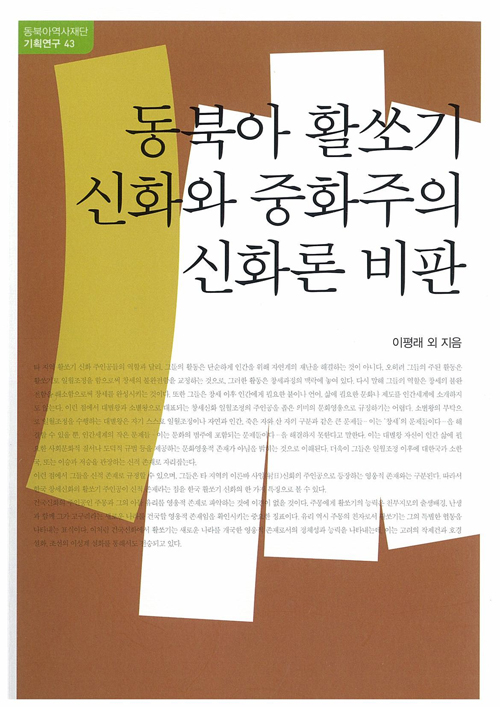Publication
- Date2011.06.20
- Hit1054

1. All rights of the contents and the electronic files in the Webpage are reserved for the Northeast Asia History Foundation.
2. No part of the Webpage may be reproduced, stored in retrieval system, or transmitted, in any form or by any means, without the prior permission.
Title : (Northeast Asian History Foundation Research Series 43)
Study of Arrow-Shooting Myths in Northeast Asia and Critical Examination of Sino-centric Interpretation of Myths in Modern China
Lee, Pyung Rae et al.
Small Octavo Edition / 260 pages / 2010 / KRW11,000 (US$9) / ISBN 978-89-6187-198-3
The title is a collection of research papers examining ancient history of Northeast Asia since 2008. It aims to examine the issues regarding China's attempts to convert the myths of ethnic minorities in China and neighboring tribes into the myths of China, and present alternatives. To this end, researchers explored common cultural phenomena in Northeast Asia regarding archery myths, and carried out a comparative analysis on China's mythology and archery myths in Korea, Siberia and Mongolia. What is notable is that the title introduces various archery myths in different parts of Northeast Asia, and raises the issue of main characters' personalities in the myths. In this title, we can learn more about the universality and difference of culture across the region where similar myths exist, and understand that myths can be interpreted differently according to change of time and ideologies, even in the same region.
Table of Contents
• Meaning and characteristics of archery myths in Korea / Lee, Yong Bhum
Ⅰ. Introduction
Ⅱ. Archery myths in Korea
1_Creation myth
2_Foundation myth
3_Origin myth
Ⅲ. Meaning of archery myths in Korea
1_Main characters in archery myths
2_Function of archery in myths
Ⅳ. Conclusion: characteristics of archery myths in Korea
• "Shaman hero" in archery myths and rituals of ethnic minorities in China / Kim, Seon Ja
― Focusing on northeast region in China
Ⅰ. Introduction
Ⅱ. Types of archery myths
1_Bow as symbol of godlike power
2_Restoring light with archery
3_Saving people from disaster by shooting the sun and the moon
Ⅲ. Ritual of shooting willow branches
1_In the case of the Khitans
2_In the case of the Jurchens
3_In the case of the Manchurians
Ⅳ. Analysis on the symbols of archery myths
1_Shaman hero reveals godlike power
2_Fighting against evil and healing humans
3_Archery myths are based on shamans' rituals
4_Archery myths did not come from “Central Plain (中原)” to northeast region
Ⅴ. Conclusion
․ Annex: archery myths of ethnic minorities in China
• Cultural implications of “Erkhii Mergen” myth / Lee, Pyung Rae
Ⅰ. Introduction
Ⅱ. Cultural implications of archery
Ⅲ. Cultural implications of thumb and making vows by cutting fingers(斷指)
Ⅳ. Cultural implications of transformation into Marmota bobak (Tarvaga)
Ⅴ. Conclusion
․ Annex: documents regarding Erkhii Mergen myth
• Meaning of bow/arrow in Siberian myths and rituals / Kwak, Jin Seok
Ⅰ. Introduction
Ⅱ. Types and main characters of archery myths in Siberia
1_Bow & archery in creation myths as a means of shamanism
2_Bow & archery in totem myths as a means of shamanism
3_Bow & archery in shaman myths as a means of rituals
Ⅲ. Siberian rituals and bow/arrow
Ⅳ. Change in perception of bow/arrow & Shamanism in Siberia
Ⅴ. Conclusion
• Who speaks of Yi (羿) the heroic archer, and why? / Lee, Eugene
― Criticism on sinocentric mythology regarding Yi of Dongyi(東夷)
Ⅰ. Introduction
Ⅱ. Between myth and history
Ⅲ. Turning myth into history
1_Why Quyuan (屈原) spoke of contradictory aspects of Yi?
2_Why Sima Qian (司馬遷) did not mention Yi?
Ⅳ. Who speaks of Yi (羿) the heroic archer, and why?
1_"Yigu (疑古)", "Xingu (信古)" and Chinese history
2_Re-recognition of Chineseness
3_Different views on Yi of Dongyi
Ⅴ. Conclusion ― Is Yi of Dongyi the Yi of China?
